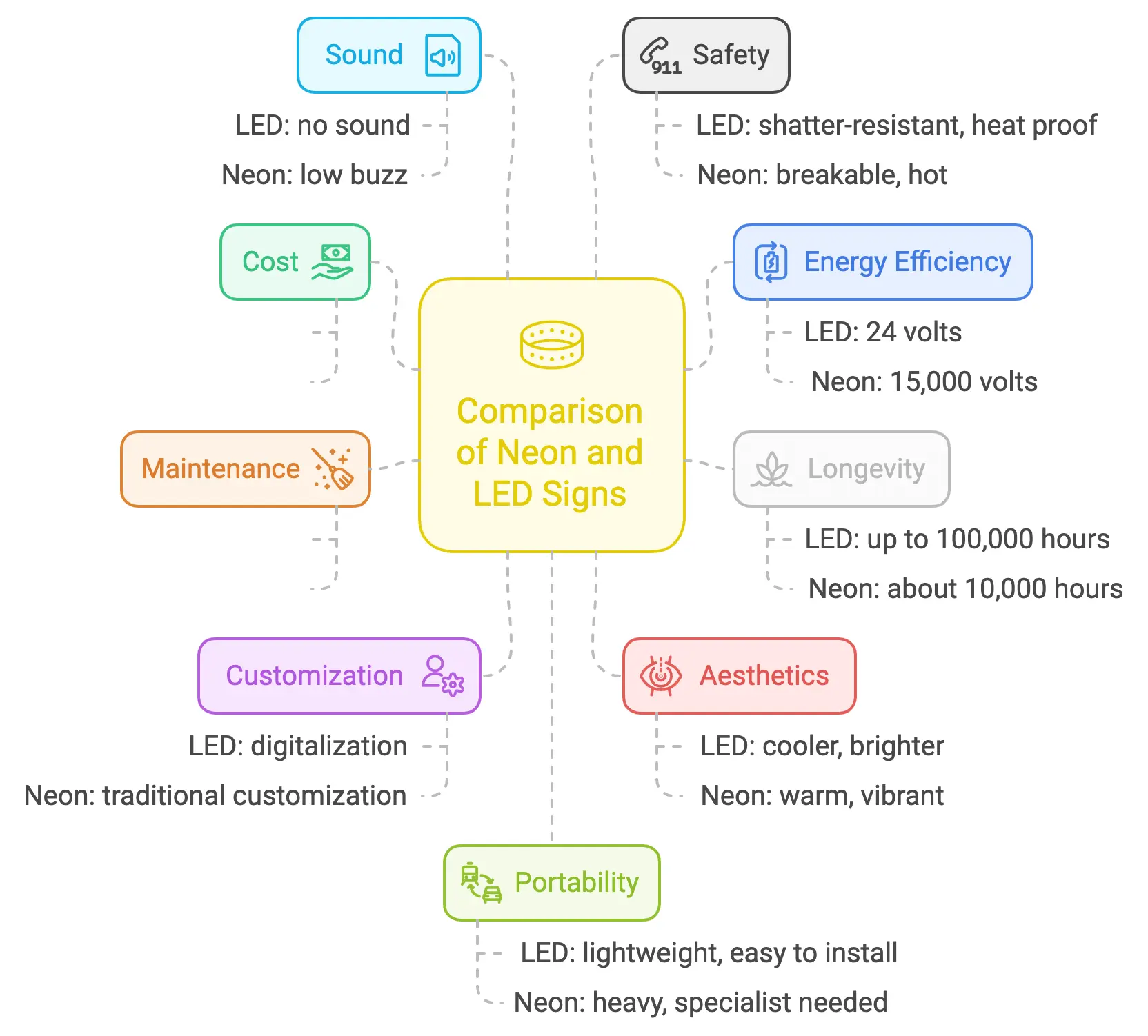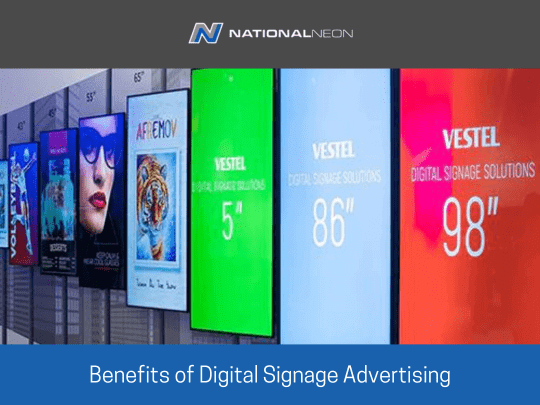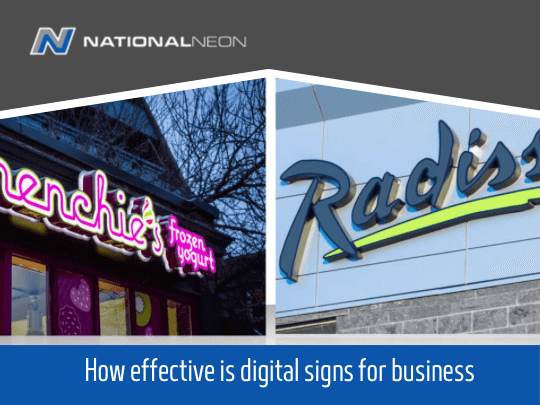Whether you are trying to get your company name in front of more people, or draw attention to a particular product or promo, the versatility of indoor and outdoor signage can pay huge dividends. It provides an easy and effective way to get your message out to everyone in close proximity to your business AND stand out in the process.
However, with technology advancing, the options for signage are expanding. So, which one should you choose?
Digital Signage
Digital signage is a catch-all phrase for any electronic display showing product information, advertising, or other messaging.
It is a rapidly growing form of media that uses electronic displays such as LCD or plasma screens to present hyper-targeted and dynamic content to viewers.
Unlike traditional advertising, which relies on static images and text, digital signage is updated in real-time, making it an ideal medium for delivering multiple messages about sales, promotions, new products, events, and more.
Thanks to the internet, customers are constantly exposed to content.
As a result, they expect to be engaged everywhere and quickly. With a digital sign, businesses can reach those customers in a manner they are used to, with constantly updated and engaging content.
Components of Digital Signage
- A Digital Display or Screen
- Media Player
- Software
- Content
How It Works
Digital signage is a relatively new technology gaining widespread adoption in various industries. The key component of this technology is its screen, which is used to display high-resolution images, video content, and other media, meaning you can show whatever you want in the highest definition possible. Alongside these dynamic displays, incorporating freestanding signage can further enhance visibility and flexibility. Freestanding signage allows for strategic placement around high-traffic areas, maximizing exposure and complementing your digital signage strategy with additional points of engagement for your audience.
These screens are typically connected to a server or network that allows users to program and manage the display content without needing to interact with them physically.
Digital signage also offers unique tracking features that allow businesses to collect valuable insights into consumer behaviors and preferences such as the time spent viewing the content, interactions with the displays, and more.
Overall, digital signs have become indispensable for businesses looking to stay competitive in today’s fast-paced world. Go to any mall to observe just how much information people are seeing, and you’ll understand the need to stand out.
Types of Digital Signage Solutions
Digital signage is comprised of multiple components, from hardware to software, which all work together to deliver your message exactly the way you want.
Communications Displays
Communication displays make it easy to convey information to large groups of people at once, allowing organizations to get important messages out to their audience in real-time.
These kinds of displays convey marketing messages or announcements to employees and visitors alike and is especially useful in an office environment.
They can also share important news or updates with customers or clients.
Infotainment
Infotainment is a growing trend in the world of digital signage solutions that include graphics and live TV or video.
Infotainment content engages viewers through dynamic graphics, and live camera feeds, creating an immersive viewing experience that sparks interest and keeps people engaged for more extended periods of time.
Also, infotainment displays can showcase everything from news and events to promotional videos and product information. They are especially effective in high foot traffic-areas, such as shopping malls and transportation hubs.
Menu Boards
One of the most common uses for digital signage is menu boards. Menu boards are typically found in quick-service restaurants, and they allow customers to view the day’s menu and place their order without having to speak to a cashier.
The menu board is connected to the restaurant’s point-of-sale system, so when an order is placed, it is automatically sent to the kitchen for preparation.
Interactive and Passive Wayfinding
Interactive and passive wayfinding are two standard digital signage options for guiding visitors from Point A to Point B, or showing them everything a particular location has to offer. Both approaches utilize various technologies, including interactive maps and digital displays, to help people find their way within businesses, malls, hospitals, airports, or public spaces.
However, there are some fundamental differences between the two types.
Interactive wayfinding typically involves touch-screen maps that allow users to search for routes based on specific keywords or destinations. These displays can also be linked to other information resources, including local weather reports and transportation schedules.
By contrast, passive wayfinding typically uses static signs that show the different directions in which visitors can travel. While this type of signage may not be as engaging as an interactive display, it is low-maintenance, a budget-friendly option, and often the right solution for businesses that don’t require their patrons to know too many details in order to get around.
Videowalls
Videowalls are a specialized type of digital sign designed specifically to display high-resolution video content.
Videowalls are gaining popularity due to their ability to engage the viewer in an impactful, visually-striking manner. These large, high-resolution display screens are composed of several individual panels that seamlessly fit together to create an immersive viewing experience.
And because videowalls are so large, they can capture the attention of a large audience of passersby and convey your messages or critical information.
Different Ways to Use Digital Signage
Service Offerings
Digital signage is a powerful tool used in various settings to enhance customer experience.
The main purpose of digital signage is to keep your customers informed about the latest happenings in your organization. This includes promoting new offers and discounts, displaying photos and videos from events you’ve hosted, showcasing recent technology advancements or changes in procedure, etc.
It is also important to present clear, concise messaging on your digital displays so that users know what you have to offer them and how they can take advantage of it. By pairing the right content with well-designed displays, you can ensure that digital signage’s benefits are fully realized for all your stakeholders.
Promotions
One common use of digital signage is for promotions or special deals. This can involve displaying ads for sales or upcoming events, highlighting featured products, or even providing information about any special offers that are currently available.
This is especially useful for catching the attention of people who might not have planned on buying from you, but are in the right place at the right time.
Social Media Streams & News
When used strategically, digital signs can engage customers and communicate important information. One helpful approach is to incorporate social media streams into your content.
By displaying posts or tweets from your business’s various social channels, you can show that you are attentive to your online community and increase your chances of getting followers when you show that you’re a fun company to engage with and have a sense of humor. Collaborating with a signage company in Toronto, Calgary, Edmonton, and Vancouver can help you effectively integrate these digital displays into your overall branding strategy. This approach not only enhances your physical presence but also bridges the gap between your online and offline interactions, creating a cohesive and engaging customer experience.
Emergency Messages
Since many digital displays are connected to the internet, people can use them to communicate important information in times of emergency.
For instance, if there were a fire or other emergency in your building, you could use digital displays to rapidly communicate this information and direct people to the nearest exit.
In addition, some facilities may use digital signage to provide essential updates on weather-related closures or other fast-moving situations that need immediate attention. By placing the relevant message on a large, dynamic screen, you can help ensure that your customers are correctly informed no matter what is happening.
BENEFITS OF DIGITAL SIGNAGE
Digital signage offers a tremendous number of advantages to all kinds of businesses, like:
Boosted Visibility
Since digital signage is so dynamic and eye-catching, it can help increase your brand visibility and awareness. Whether you’re displaying targeted ads or simply showcasing your latest products, this type of marketing increases your chance of catching the eyes of potential customers.
Aesthetic Appeal
Digital signs are also highly customizable, allowing you to design and display content that matches your brand’s style. Because they are essentially big computer screens, you have endless options for creating a truly engaging customer experience.
Up-to-date Information
Using digital signs means having real-time updates and always presenting people with the most accurate information. Whether it’s displaying social media posts, weather updates, or relevant content, this marketing tool helps keep your brand up-to-date and in line with the latest trends.
Personalized Messaging
Creating a custom content strategy for each digital sign allows you to deliver highly targeted messages to customers based on their precise location in your store or business. Think about having a message about a sale on jeans in a section with T-shirts. This would drive jean sales for people who were in a different section, and all they needed to buy a pair of jeans was that little push over the edge by seeing something out of the corner of their eye (or right in their face). Integrating storefront signage with your digital signage strategy can enhance this effect, making your promotions more visible both inside and outside the store. This cohesive approach ensures that your marketing messages are reinforced at multiple customer touchpoints, maximizing impact and driving sales.
Reduced Perceived Wait Time
Customers are always on-the-go and don’t want to spend a lot of time waiting in line, which is why digital displays can be such an effective tool for reducing perceived wait time. By displaying information about when customers will be served or offering them something to watch that keeps them from feeling bored and impatient, you can help create a more pleasant experience for your customers. Additionally, incorporating Indoor and Interior Business & Office Signage into your overall design can complement these digital displays by enhancing the aesthetic appeal of your space and providing consistent branding throughout your business environment. This integrated approach helps maintain engagement and satisfaction, making the wait feel even shorter.
Easy Edits and Updates
The flexibility of digital signage lets you edit and update content remotely, and you don’t need to rely on costly or time-consuming solutions for updating your displays. Whether making last-minute changes or scheduling regular updates, this will help streamline the process and save you time and money.
Overall, digital signs have become an indispensable tool for communicating with customers and engaging them in meaningful ways. Whether you’re using it to build brand awareness, promote your products or services, or keep customers up-to-date on the latest sales, it is surely a practical addition to any organization.
Contact National Neon for All Your Digital Signage Needs
When you’re looking to add digital signage to your business, look no further than National Neon. We can be your trusted one-stop shop for all signage solutions. We specialize in delivering custom digital signage tailored to your business’s unique needs.
Enhance the look of your business and draw in new clients with custom digital signage from National Neon.


















